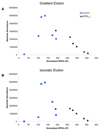Evaluation of the ALiPHAT method for PC-IDMS and correlation of limits-of-detection with nonpolar surface area
- PMID: 19734056
- PMCID: PMC2763965
- DOI: 10.1016/j.jasms.2009.07.019
Evaluation of the ALiPHAT method for PC-IDMS and correlation of limits-of-detection with nonpolar surface area
Abstract
PC-IDMS experiments for two peptides, laminin nonapeptide and the N-terminal tryptic peptide of prostate specific antigen, were performed utilizing a variety of alkylating reagents. These experiments were conducted to investigate how hydrophobicity influences the limits-of-detection (LOD) by altering their electrospray ionization response. Nonpolar surface areas were calculated for both peptides and all alkylating reagents to provide an estimate of the hydrophobicity of the differently alkylated peptides. Decreases in LOD by 2-fold were observed for both peptides between the best and worst performing combination of alkylating reagent. However, while an increase in hydrophobicity was found to aid in decreasing LOD to an extent, beyond a certain hydrophobicity, we observed a decrease.
Figures




Similar articles
-
Evaluating nonpolar surface area and liquid chromatography/mass spectrometry response: an application for site occupancy measurements for enzyme intermediates in polyketide biosynthesis.Rapid Commun Mass Spectrom. 2014 Dec 15;28(23):2511-22. doi: 10.1002/rcm.7051. Rapid Commun Mass Spectrom. 2014. PMID: 25366398 Free PMC article.
-
Improving limits of detection for B-type natriuretic peptide using PC-IDMS: an application of the ALiPHAT strategy.Analyst. 2010 Jan;135(1):36-41. doi: 10.1039/b919484c. Epub 2009 Nov 19. Analyst. 2010. PMID: 20024179 Free PMC article.
-
Absolute quantification of the model biomarker prostate-specific antigen in serum by LC-Ms/MS using protein cleavage and isotope dilution mass spectrometry.J Proteome Res. 2004 May-Jun;3(3):644-52. doi: 10.1021/pr049963d. J Proteome Res. 2004. PMID: 15253448
-
Quantitative protein analysis using enzymatic [¹⁸O]water labeling.Curr Protoc Protein Sci. 2014 Apr 1;76:23.4.1-23.4.9. doi: 10.1002/0471140864.ps2304s76. Curr Protoc Protein Sci. 2014. PMID: 24692014 Free PMC article. Review.
-
Isotope-dilution mass spectrometry in clinical chemistry.Adv Clin Chem. 1985;24:111-61. doi: 10.1016/s0065-2423(08)60272-3. Adv Clin Chem. 1985. PMID: 3911749 Review. No abstract available.
Cited by
-
Hydrophobic derivatization of N-linked glycans for increased ion abundance in electrospray ionization mass spectrometry.J Am Soc Mass Spectrom. 2011 Aug;22(8):1309-17. doi: 10.1007/s13361-011-0140-x. Epub 2011 May 3. J Am Soc Mass Spectrom. 2011. PMID: 21953184 Free PMC article.
-
Evaluating nonpolar surface area and liquid chromatography/mass spectrometry response: an application for site occupancy measurements for enzyme intermediates in polyketide biosynthesis.Rapid Commun Mass Spectrom. 2014 Dec 15;28(23):2511-22. doi: 10.1002/rcm.7051. Rapid Commun Mass Spectrom. 2014. PMID: 25366398 Free PMC article.
-
Interplay of permanent charge and hydrophobicity in the electrospray ionization of glycans.Anal Chem. 2010 Aug 1;82(15):6636-42. doi: 10.1021/ac101227a. Anal Chem. 2010. PMID: 20590124 Free PMC article.
-
Improving limits of detection for B-type natriuretic peptide using PC-IDMS: an application of the ALiPHAT strategy.Analyst. 2010 Jan;135(1):36-41. doi: 10.1039/b919484c. Epub 2009 Nov 19. Analyst. 2010. PMID: 20024179 Free PMC article.
-
New ionization tags based on the structure of the 5-azoniaspiro[4.4]nonyl tag for a sensitive peptide sequencing by mass spectrometry.Anal Bioanal Chem. 2018 Feb;410(4):1311-1321. doi: 10.1007/s00216-017-0771-2. Epub 2017 Dec 6. Anal Bioanal Chem. 2018. PMID: 29214541 Free PMC article.
References
-
- Barr JR, Maggio VL, Patterson DG, et al. Isotope dilution mass spectrometric quantification of specific proteins: Model application with apolipoprotein A-I. Clin. Chem. 1996;42(10):1676–1682. - PubMed
-
- de Leenheer AP, Thienpont LM. Applications of Isotope-Dilution Mass-Spectrometry in Clinical-Chemistry, Pharmacokinetics, and Toxicology. Mass Spectrom. Rev. 1992;11(4):249–307.
-
- Gygi SP, Rist B, Gerber SA. Quantitative analysis of complex protein mixtures using isotope-coded affinity tags. Nat. Biotechnol. 1999;17(10):994–999. - PubMed
-
- Zhou HL, Ranish JA, Watts JD, et al. Quantitative proteome analysis by solid-phase isotope tagging and mass spectrometry. Nature Biotechnology. 2002;20(5):512–515. - PubMed
-
- Li JX, Steen H, Gygi SP. Protein profiling with cleavable isotope-coded affinity tag (cICAT) reagents - The yeast salinity stress response. Mol. Cell. Proteomics. 2003;2(11):1198–1204. - PubMed
Publication types
MeSH terms
Substances
Grants and funding
LinkOut - more resources
Full Text Sources

